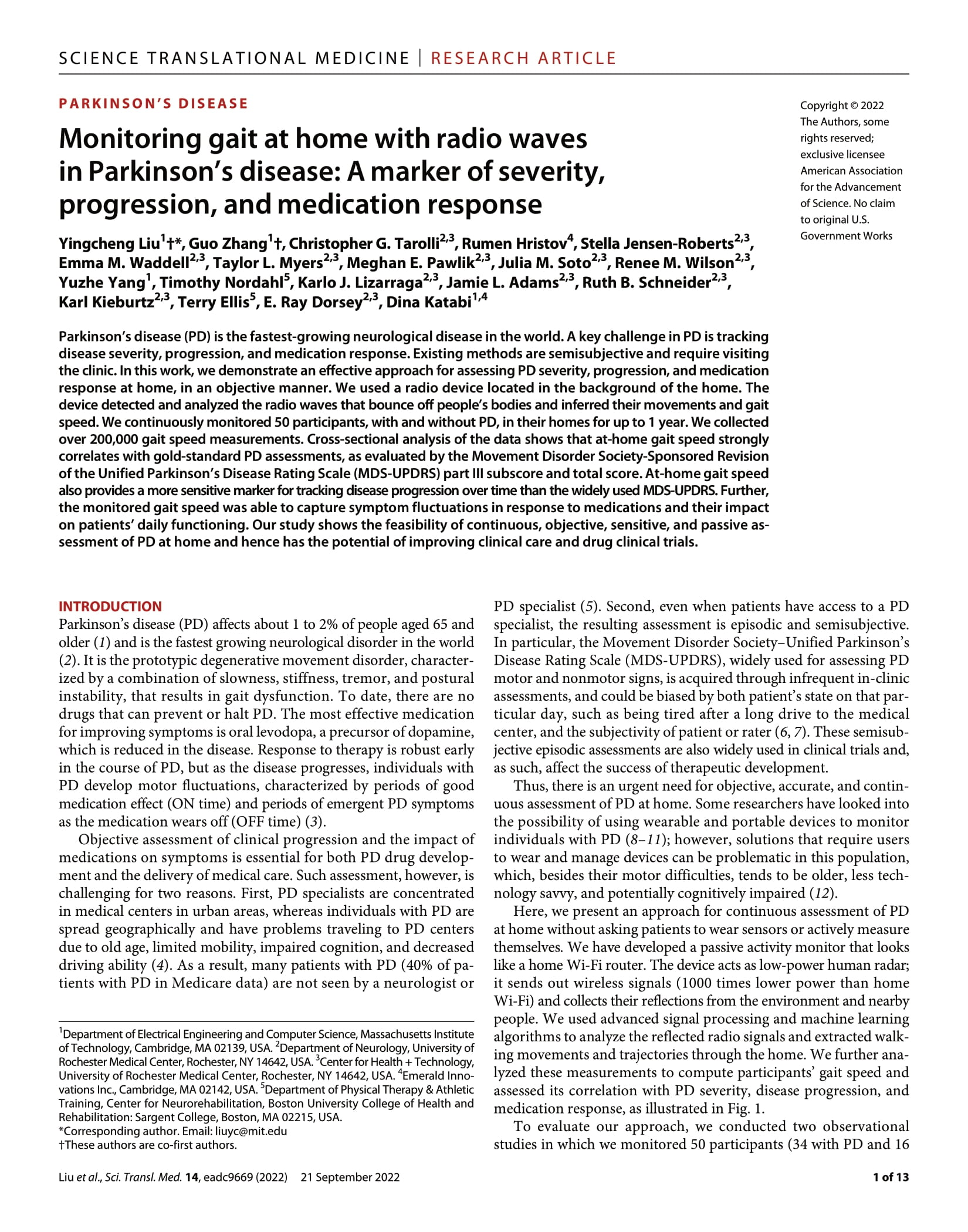Yingcheng Liu* 1, Guo Zhang* 1, Christopher G. Tarolli 2, Rumen Hristov 3, Stella Jensen-Roberts 2, Emma M. Waddell 2, Taylor L. Myers 2, Meghan E. Pawlik 2, Julia M. Soto 2, Renee M. Wilson 2, Yuzhe Yang 1, Timothy Nordahl 4, Karlo J. Lizarraga 2, Jamie L. Adams 2, Ruth B. Schneider 2, Karl Kieburtz 2, Terry Ellis 4, E. Ray Dorsey 2, Dina Katabi 1,3
1 MIT CSAIL 2 University of
Rochester Medical Center 3 Emerald
Innovations, Inc. 4 Boston University
College of Health and Rehabilitation
(* denotes
equal contributions)
Parkinson’s disease (PD) is the fastest-growing neurological disease in the world. A key challenge in PD is tracking disease severity, progression, and medication response. Existing methods are semi-subjective and require visiting the clinic. In this work, we demonstrate an effective approach for assessing PD severity, progression, and medication response at home, in an objective manner. We used a radio device located in the background of the home. The device detected and analyzed the radio waves that bounce off people’s bodies and inferred their movements and gait speed. We continuously monitored 50 participants, with and without PD, in their homes for up to one year. We collected over 200,000 gait speed measurements. Cross-sectional analysis of the data shows that at-home gait speed strongly correlates with gold-standard PD assessments, as evaluated by the Movement Disorder Society-Sponsored Revision of the Unified Parkinson’s Disease Rating Scale (MDS-UPDRS) part Ⅲ sub-score and total score. At-home gait speed also provides a more sensitive marker for tracking disease progression over time than the widely used MDS-UPDRS. Further, the monitored gait speed was able to capture symptom fluctuations in response to medications and their impact on patients’ daily functioning. Our study shows the feasibility of continuous, objective, sensitive, and passive assessment of PD at home, and hence has the potential of improving clinical care and drug clinical trials.
TL;DR: Contactless monitoring gait at home using radio signals tracks Parkinson’s disease severity, progression, and medication response.

|
Monitoring Gait at Home with Radio Waves in Parkinson's Disease:
a Marker of Severity, Progression, and Medication Response
Yingcheng Liu*, Guo Zhang*, Christopher G. Tarolli, Rumen Hristov, Stella Jensen-Roberts, Emma M. Waddell, Taylor L. Myers, Meghan E. Pawlik, Julia M. Soto, Renee M. Wilson, Yuzhe Yang, Timothy Nordahl, Karlo J. Lizarraga, Jamie L. Adams, Ruth B. Schneider, Karl Kieburtz, Terry Ellis, E. Ray Dorsey, Dina Katabi Science Translational Medicine, 2022. [Paper (free-access)] [Bib] |